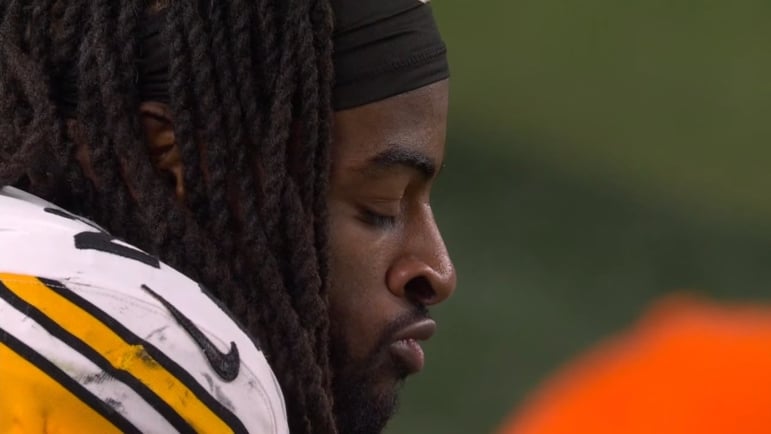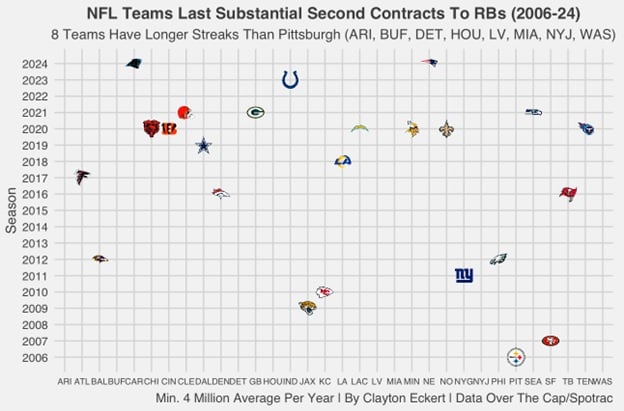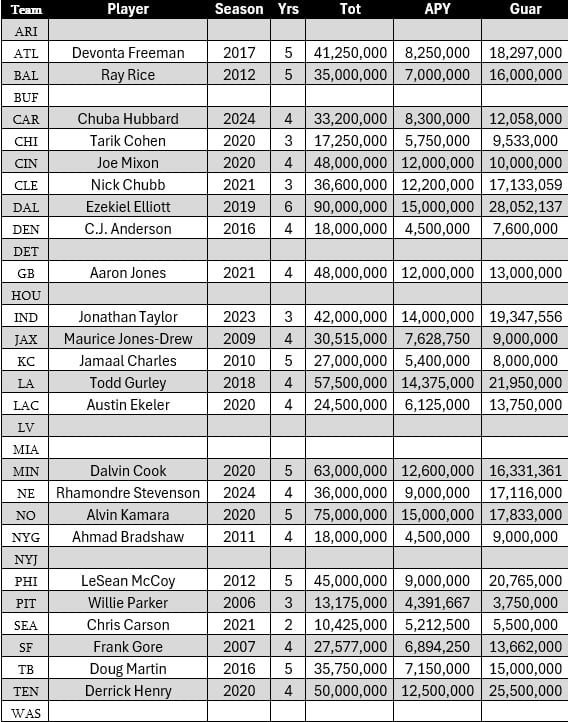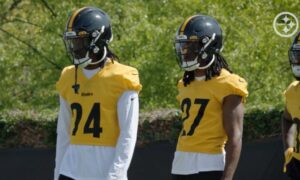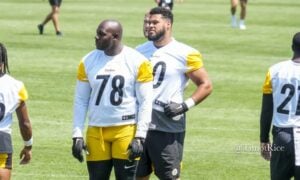An interesting conversation brewed on a recent episode of the Terrible Podcast. A question arose: Was Pittsburgh behind the times in signing a RB to a substantial second contract with their original team? Willie Parker was the last instance for the Steelers in 2006, signing a multi-year second contract with a $4.4 million APY (average per year).
The point is topical, considering two Pittsburgh running backs, Najee Harris and Jaylen Warren, could potentially break this streak.
I scoured the data, seeing when the last time every NFL team signed a RB under these parameters: second contract with original team, multi-year, and minimum 4-million APY. Here’s a visual of team results:
The notion that the 2006 Parker deal was low in the results was validated. This 18-year drought is the 24th longest in the NFL. Several teams had multiple occurrences in the span, so the argument of it being time holds merit. On the flip side, eight teams had a longer streak than Pittsburgh: ARI, BUF, DET, HOU, LV, MIA, NYJ, and WAS.
Of course, a deserving player is needed on the other end, which the Steelers arguably did. Since 2006, some notable names have been passed on for substantial second contracts. A couple of recent examples were Le’Veon Bell (two franchise tags before moving on) and James Conner (who let his rookie deal expire). Questions of what could have been.
Will Pittsburgh pull the trigger with Harris and/or Warren? Many found not picking up Harris’ fifth-year option on his rookie deal curious at the time. He of course has been one of the most durable backs, posting his fourth-straight 1,000-yard season. Volume is a major part of that, while efficiency, not so much.
Warren’s role has increased: a great 1B option and third-down back skillset (pass-catching/blocking). There is the tender level conundrum for Warren, the best case of two options being a second-round restricted tender of $5.217 million. Or, perhaps, a starting point for a multi-year negotiation. It’s a better fit for OC Arthur Smith’s system, too.
The position is one of the most depreciated in terms of contracts, so the Steelers not shelling them out left and right is positive. But seeing how long it’s been and the opportunity to end the streak will be fascinating to monitor.
Here is a table by team, the player and season they signed, years of the deal (Yrs), total value (Tot), average per year (APY), and guaranteed money (Guar):
It’s an interesting trip down memory lane. First, two qualifiers signed such contracts in 2024: NE Rhamondre Stevenson and CAR Chuba Hubbard. One occurrence in 2023, a more notable name: IND Jonathan Taylor. No players in 2022. So, in the last three seasons, only three players have fit the parameters. These contracts are all active.
Three players in 2021: Nick Chubb (CLE), Aaron Jones (GB), and Chris Carson (SEA). Chubb and Jones are set to become free agents, while Carson retired after just five seasons (injury).
2020 featured the most signings of the study, with six RBs. Alvin Kamara (NO), Dalvin Cook (MIN), Derrick Henry (TEN), Joe Mixon (CIN), Austin Ekeler (LAC), Tarik Cohen (CHI). It is an excellent group of names and results for the most part, but most players have moved to other teams since, with Kamara being the exception.
Then, a few years of only one signing. 2019: Ezekiel Elliott (DAL). 2018: Todd Gurley (LA). 2017: Devonta Freeman (ATL). 2016 had two players – Doug Martin (TB) and C.J. Anderson (DEN). From 2013-2015, there was a three-year lull of no such signings. Two in 2012: LeSean McCoy (PHI) and Ray Rice (BAL). Also, pretty solid list at the time.
In 2011, the Giants’ last occurrence was Ahmad Bradshaw. New York fans have an even bigger reason to complain about their streak, considering they had the opportunity with Saquon Barkley last offseason. Instead, he moved on to the Eagles for a Super Bowl and 2,000-plus rushing season. Free agency has been a more popular avenue of late for contenders, as we also saw with Henry going to Baltimore.
Kansas City’s last time was in 2010, when they re-signed Jamaal Charles. The Jaguars’ last time was with Maurice Jones-Drew in 2009. After none in 2008, the final qualifier since Pittsburgh’s drought was Frank Gore in 2007 (SF).
Then, there was Pittsburgh, the lone example in 2006 with Willie Parker.
So, we can see Pittsburgh has been one of the most cautious NFL teams in delving out second RB contracts of substance. For the most part, teams inked deals to star players that largely paid off.
There are a couple of what-if opportunities for the Steelers, and the big question is if Najee Harris or Jaylen Warren are viewed in this light and done enough to ink such a contract. Fortunately, it doesn’t seem either would “break the bank” if they finally go that route.
Regardless of who is retained and/or brought in, improvements and consistency on the offensive line should be a primary focus for Pittsburgh’s offense. It is also a strong draft class at RB that the Steelers could capitalize on if they choose.
One thing’s for sure: the Steelers are past due in this regard at the position, with the 24th-longest drought (18 years). Najee Harris will test free agency, and as the study revealed, a high percentage of RBs ended up with new teams in this situation.
I’m personally hoping they ink Jaylen Warren to a new deal. He has a more varied skillset and fits Arthur Smith’s rushing schemes well. Pittsburgh’s decision on the matter can’t come soon enough.

